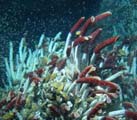


Glycans are sugars that occur throughout living things and are particularly abundant on the surfaces of cells. Berkeley Lab's Carolyn Bertozzi has developed a series of techniques to manipulate glycans that provide, among other uses, a new way of visualizing vertebrate development. “We found some interesting and totally unexpected patterns as the sugars moved and clustered in certain areas,” Bertozzi says, “It’s like putting a new telescope up to the stars and seeing something new. And then you have to figure out what it is.” More>
 Research: Sequencing Technology Pinpoints 'On-Off Switches' in Genomes
Research: Sequencing Technology Pinpoints 'On-Off Switches' in GenomesScientists from the Joint Genome Institute, Berkeley Lab, and UC San Diego have developed a set of molecular tools that provide important insight into the complex genomes of multicellular organisms. The strategy promises to clarify the longstanding mystery of the role played by vast stretches of DNA sequence that do not code for the functional units — genes — that nevertheless may have a powerful regulatory influence. More>
 Scientists have discovered that iron "dust" can be carried to the ocean not only by rivers or blown to sea, but can also rise from the ocean floor. Researchers found iron — a limiting nutrient for most marine life — can float up from the sea floor as plumes spewed from hydrothermal vents. Spectromicroscopic measurements performed at the Advanced Light Source revealed that hydrothermally vented Fe(II), the bioavailable form of Fe, is stabilized by organic matter. The research was led by Brandy Toner (Woods Hole Oceanographic Institute), with participation by Berkeley Lab’s Sirine Fakra and Matthew Marcus. A paper on this discovery appears in Nature Geoscience. More>
Scientists have discovered that iron "dust" can be carried to the ocean not only by rivers or blown to sea, but can also rise from the ocean floor. Researchers found iron — a limiting nutrient for most marine life — can float up from the sea floor as plumes spewed from hydrothermal vents. Spectromicroscopic measurements performed at the Advanced Light Source revealed that hydrothermally vented Fe(II), the bioavailable form of Fe, is stabilized by organic matter. The research was led by Brandy Toner (Woods Hole Oceanographic Institute), with participation by Berkeley Lab’s Sirine Fakra and Matthew Marcus. A paper on this discovery appears in Nature Geoscience. More>
 [R&D Magazine] Among the dozens of websites featuring the supercharged ion generator devised by physicist Andre Anders (pictured) of the Lab’s Accelerator and Fusion Research Division and former Lab physicist Joakim Andersson, is R&D Magazine. Its online edition hosts a blog that has sparked a lively discussion of the technique for sputtering high-quality thin films on industrially important substrates. Anders and Andersson contribute to the go-around and cast light on the evolution of the technique. More>
[R&D Magazine] Among the dozens of websites featuring the supercharged ion generator devised by physicist Andre Anders (pictured) of the Lab’s Accelerator and Fusion Research Division and former Lab physicist Joakim Andersson, is R&D Magazine. Its online edition hosts a blog that has sparked a lively discussion of the technique for sputtering high-quality thin films on industrially important substrates. Anders and Andersson contribute to the go-around and cast light on the evolution of the technique. More>
 Members of the East Bay Green Corridor initiative met at the Joint BioEnergy Institute in Emeryville last Monday. The gathering was hosted and facilitated by the Lab’s Government and Community Affairs Office. After a brief tour of JBEI, the group discussed plans for business development, assistance and retention, career pathways and workforce development, research, marketing, and public policy coordination. The East Bay Green Corridor was established in 1997 to support emerging green and sustainable industries and alternative energy research in the area. Corridor members include the mayors of Berkeley, Emeryville, Oakland and Richmond, the UC Berkeley Chancellor and Berkeley Lab Director Paul Alivisatos.
Members of the East Bay Green Corridor initiative met at the Joint BioEnergy Institute in Emeryville last Monday. The gathering was hosted and facilitated by the Lab’s Government and Community Affairs Office. After a brief tour of JBEI, the group discussed plans for business development, assistance and retention, career pathways and workforce development, research, marketing, and public policy coordination. The East Bay Green Corridor was established in 1997 to support emerging green and sustainable industries and alternative energy research in the area. Corridor members include the mayors of Berkeley, Emeryville, Oakland and Richmond, the UC Berkeley Chancellor and Berkeley Lab Director Paul Alivisatos.
The Lab’s virtual private network (VPN) service provides unrestricted access to LBLnet, via an encrypted connection, for employees on travel or otherwise working from remote locations. A new VPN server with additional features was recently installed. Current VPN users are encouraged to migrate to this new server at their earliest convenience, and must do so before May 14, when the old servers are removed from service. More>
 Special Event: Final Call for BERC Energy Symposium Poster Session
Special Event: Final Call for BERC Energy Symposium Poster SessionThe BERC Energy Symposium (Feb. 23) brings together venture capitalists, industry partners, UC Berkeley students and faculty, and Berkeley Lab scientists to exchange ideas on energy science, business and policy. The symposium features a poster session, which in past years has served as a great showcase for UC Berkeley and Berkeley Lab. If your research involves energy and resources from a scientific, policy, or technological perspective, consider submitting a poster describing that work. The winner of the first-place poster prize will get $1,000, with two runner-up prizes of $500 each. Participants will receive free admission to the symposium and a free lunch. Submit a poster title, researcher names, and a short abstract (150 words or less) here by Thursday.